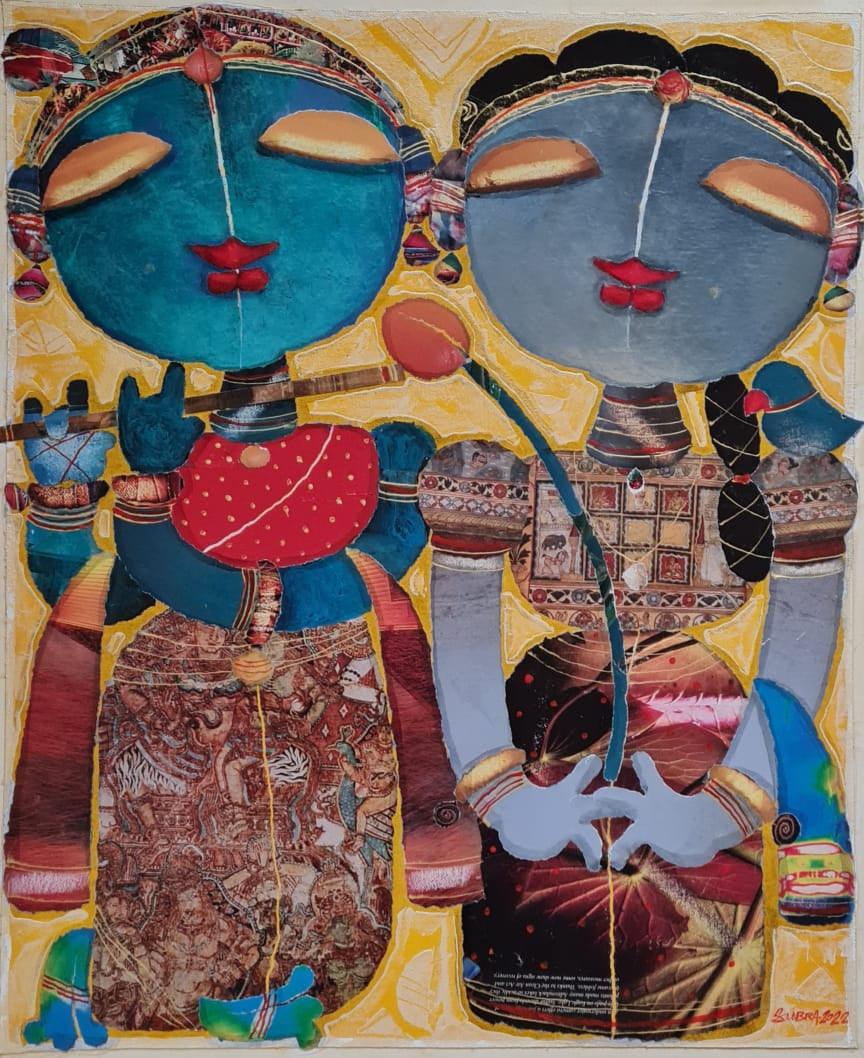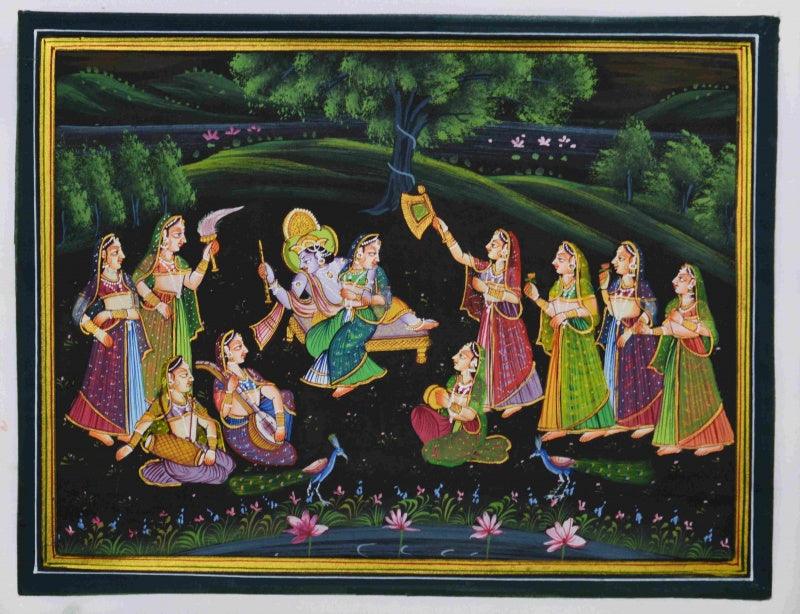Introduction
For centuries, Radha and Krishna's divine romance has provided artists with endless sources of artistic inspiration. Representing spiritual love and devotion beyond earthly boundaries, their story transcends earthly confines symbolizing union between individual souls (jivatmas) and ultimate souls (paramatmas). Additionally, various avatars of Krishna each carrying special significance feature prominently in Indian art - this blog explores this rich tapestry by delving deeper into paintings depicting Radha Krishna and their avatars while delving into themes symbolism and artistic evolution over time.
Radha and Krishna's Eternal Love Story
Themes and Symbolism
Radha and Krishna's love story is not simply romantic in its interpretation; rather it stands as an embodiment of longing and union between human soul and divine forces. Their romantic tale has long been depicted by Indian art to capture all its emotions as well as transcendent quality of their relationship.
Divine Love: Radha and Krishna symbolically symbolize divine love as it transcends physical attraction to establish an inexhaustible spiritual bond between themselves that goes far beyond any physical attraction.
Bhakti (Devotion): Paintings often represent the ideals of Bhakti movement, emphasizing loving devotion to God. Radha's unconditional love and complete surrender to Krishna serve as models for devotees who practice Bhakti.
Rasa Lila: One of the most beloved themes is Rasa Lila, or Krishna's divine dance with Radha and her cowherd girls known as Gopis (cowherd girls). This dance symbolizes our joyous union with divine spirit. Iconic Paintings and Styles Mughal Miniature Paintings.
Mughal miniatures from the 16th to 18th centuries are widely recognized for their intricate details, vibrant hues, and exquisite depictions of Radha Krishna. These paintings often portray them in lush landscapes with lush vegetation to emphasize nature's beauty as well as divine love pervading it all.
Characteristics of Radha Krishna miniatures include detailed brushwork, elaborate costumes, expressive faces, and ornate backgrounds.
Artists and Patrons: Akbar, Jahangir and Shah Jahan were notable patrons of the arts, producing some of the finest Radha Krishna miniatures ever.
Rajput Paintings
Rajput paintings from Rajasthan and Pahari (Himachal Pradesh) offer an exquisite and profoundly spiritual depiction of Radha Krishna.
Characteristics: Bold colors, strong lines, and more stylized forms that focus on creating a spiritual aura for divine couples. Pahari Paintings are particularly notable for their romantic and lyrical quality that captures this romanticism in an indescribably dreamlike fashion.
Bengal School of Art
The Bengal School of Art emerged during the early 20th century, combining traditional Indian styles with modern techniques. Artists like Abanindranath Tagore brought new vibrancy and spiritual renewal into Radha Krishna depictions, imbuing them with nationalism.
Characteristics: Soft and flowing lines with pastel colors that emphasize emotional depth and spiritual intensity are hallmarks of beauty in this piece.
Krishna As An Avatar Of Vishnu
Krishna, as an avatar or role of Vishnu, takes many different forms and characters that each have special stories and meaning. Indian art depicts these various manifestations of divine intervention throughout its many paintings depicting them.
Krishna as the Butter Thief (Makhan Chor)
One of Krishna's endearing childhood qualities often seen depicted in paintings is his playful character as the Butter Thief.
These paintings capture Krishna's innocence, playfulness and divine mischief through his fondness for butter and his antics in Vrindavan.
Iconic Depictions: Artists often depict young Krishna with a pot of butter in hand, surrounded by gopis who complain to his mother Yashoda about him. Their mischievous smile and dynamic poses capture his playful spirit perfectly. Krishna Lifting Govardhan Hill
This theme symbolizes Krishna's divine protection of Vrindavan from Indra's rainfall, who threatened its citizens with harsh conditions.
Theme: Divine power, protection and leadership. Krishna effortlessly lifting Govardhan Hill with one finger serves as a powerful symbol of his divine strength and goodness.
Iconic Depictions of Krishna: Paintings often show him under a hill with villages and livestock seeking shelter, showing his dramatic and miraculous nature.
Krishna as Charioteer in Mahabharata (Sarathi).
Krishna plays an instrumental role in Arjuna's battle strategy at Kurukshetra. He acts as his guide and charioteer.
Themes: Duty, righteousness (dharma), and divine guidance are central tenants of Hindu philosophy; Krishna's address to Arjuna known as the Bhagavad Gita is considered an authoritative work on these subjects.
Iconic Depictions: Paintings depicting iconic depictions of Krishna typically feature him acting as Sarathi (charioteer), taking control of Arjuna's reins while imparting wisdom and offering advice. The battlefield backdrop and presence of divine aura around Krishna emphasize its spiritual importance in Arjuna's contemplative mind. Krishna with His Flute (Murali Manohar).
Krishna playing his flute has long been seen as a symbolic representation of divine music and spiritual ecstasy.
Themes: Harmony, divine music and connection to the divine through flute music. The flute's melodies are said to capture all living beings' attention as a representation of divine call.
Iconic Depictions: Paintings commonly depict Krishna standing in an elegant three-bend pose while playing his flute against an idyllic Vrindavan landscape complete with cows, gopis, and lush vegetation - this imagery highlights Krishna's peaceful and endearing features.
Artistic Styles
Over time, depictions of Radha Krishna and Krishna's avatars have changed over time to reflect changing aesthetics, regional influences, and cultural environments.
Temple Art and Sculpture in Early Medieval Period
Early depictions of Krishna can be found in temple sculptures that feature him in various forms and narratives, with emphasis being placed on strong forms with intricate carvings to symbolize both his divine qualities as well as his heroic ones.
Mughal and Rajput Eras Mughal Miniatures: These paintings incorporated Persian influences, with detailed realism, rich colors, and elaborate backgrounds being the hallmarks of Mughal Miniature paintings. Love scenes between Radha and Krishna were especially notable; delicately depicted blending Persian and Indian aesthetics into each miniature masterpiece.
Rajput Paintings: Rajput art from Rajasthan and Pahari regions evolved a distinctive style characterized by bold lines, vivid colors, and devotional themes such as Radha Krishna's love. Rajput miniatures often depicted these depictions with spiritual intimacy and cultural richness.
Colonial Period and Bengal Renaissance Company School: During British colonial rule in India, the Company School of painting emerged, which fused traditional Indian subjects with European techniques. Radha Krishna paintings created during this era often had more realistic styles influenced by Western art.
Bengal School: Beginning in the early 20th century, led by figures such as Abanindranath Tagore, the Bengal School of Art sought to revive traditional Indian art forms. Their portrayals of Radha Krishna embodied spiritual and nationalist feelings while using soft colors and lyrical compositions to convey feelings of divine love as well as cultural pride.
Contemporary Interpretations
Abstract and Modernist Art: Today's artists continue to interpret Radha Krishna themes through abstract and modernist painting styles. Their paintings often focus on depicting both emotional and symbolic aspects of their relationship using bold colors, abstract forms, and inventive compositions.
Fusion Styles: Contemporary artists frequently combine traditional motifs with contemporary techniques, producing works that speak both to historical depth and contemporary sensibilities. Digital art and mixed media have also gained in popularity as new ways to illustrate Radha Krishna's timeless love story.
Conclusion
Artistic depictions of Radha Krishna and Krishna's avatars span centuries and styles in India, reflecting its rich cultural, spiritual, and artistic heritage. From Mughal miniatures and bold Rajput paintings to Bengal School and contemporary interpretations - each period contributed its unique touch towards creating a dynamic tapestry celebrating divine love, devotion, and Krishna's many aspects - celebrating divine love, devotion, and his multidimensional nature in glorious paintings that preserve timeless stories while inspiring audiences with their power of representation and imagery. These paintings not only preserve timeless stories involving Radha Krishna but continue to captivate audiences with its power to inspire audiences wit its depiction while inspiring audiences with its presence.










